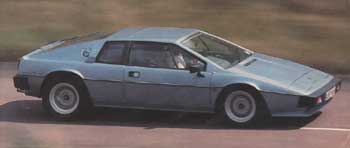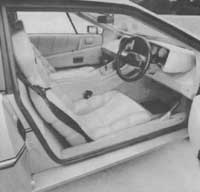

Lotus Esprit S3
AutoCar Road test
It's not an easy car to get in and out of, with its low door opening, made more awkward by that sharply-raked windscreen, and the handbrake protuding out of the door sill doesn't help, either. Our test car fluffed and spluttered a lot before eventually coughing into life when asked to restart after a fast run; that may have been a result of the exceptionally warm weather, but that weather just went to show up the inadequacies of the Esprit 3's ventilation — even with the fan on full you need the windows cracked open to breathe on a a hot day.
However, once you've wriggled your way in behind the wheel, wrestled with the starter and found the switches on the central console that work the electric window winder, there isn't a car you'd rather be in. It's that sort of machine — it has the eyecatching looks to boost your ego as you trickle through town traffic, and it has the power to back up those looks.
That engine is really incredibly smooth. The oversquare 2,173 c.c. double overhead camshaft, all-alloy unit delivers 160bhp at 6,500 rpm, with a hefty 160 lb.ft. of torque available at 5,000 rpm.
With the torque and power peaks so close to the engine's nominal maximum speed, 7,000 rpm, the engine looks on paper to be rather peaky, but in practice is pulls well from 2,000 rpm and whips zestfully through its rev range, so much so that it comess as something of a surprise when the rev limiter cuts in.
Good traction allows a quick getaway. Dropping the clutch at around 5,000 rpm generatess enough wheelspin to keep the engine on song until road speed catches up with engine revs, so that 30mph comes up in a creditable 2.5 seconds. Second gear is good for 62mph, so that only one gearchange is required in that all-important 0-60mph dash. It just so happens, however, that the 1-to-2 gearshift in the Esprit 3 requires a particularly long movement of the lever, so that it is a difficult change to 'snick' through. Hard as we tried, we found it difficult to better 7.3 seconds for the 0-60mph dash, though we have achieved the 6.7 seconds claimed by Lotus in a similar car tried in 1981.
Easier gear-lever movement between second and third and third to higher speeds, so that our test car matched the previous car's 0-100mph acceleration of 20.9 sec.
Outright top speed was a little disappointing; Lotus claim 138mph in fifth, but eight consecutive laps of the 2-mile high-speed banked bowl at Vauxhall Motors' test facility at Millbrook failed to return better than a 130mph mean, with a maximum of 133mph; in fairness to the car, we had to test in conditions that saw wind blustering up to 20mph at times.
The gear ratios are well stepped, so that at the power peak crankshaft speed first is good for 38mph, second for 57mph, third for 85mph and fourth for 115mph. Fifth gear is an overdrive ratio, though the car achieves its maximum speed in that gear. The top speed of 130mph comes up at 5,700 rpm, some way below the 6,500 rpm power peak. This overgearing is not felt, however, in any noticeable lack of top gear performance.
We may not have been able to match Lotus' claimed figures, but performance is still good for the class — and so is the fuel consumption, which worked out at a very creditable 23.2mpg for the 940-mile test period, including an interim return of 26.3mpg after a stretch of averagely enthusiastic driving — that is, making full use of the car's acceleration and handling, but remaining within the confines of legality — including some round-town traffic, country lanes and a good percentage of motorway cruising.
Fuel tank capacity is 14.75 gallons, in two tanks, each with its own filler, connected by balance pipe. Taking the full 14.75 gallons on board, however, is a laborious affair. It is difficult to get the fillers to accept the full flow of a petrol pump nozzle, and the action of the linking balance pipe in slowly transferring fuel from on tank to the other makes is difficult to brim the tanks accurately. The recommended procedure is to move from side to side of the car, topping each tank in turn until both are full. Either that or settle or a less-than-full tank and reduced range.
The long-legged 22.7mph/1,000rpm fifth gear is an obvious economy aid on the motorway; it also helps to keep enging noise down since at the legal limit the engine is purring over at 3,000rpm.
Noise is well controlled on the Lotus Esprit 3. The engine has a pleasant sporty sound, well suited to the character of the car, and though some body boom develops above 6,000rpm it is unlikely that the average driver will keep the engine at that speed for long.
Road nosie is no worse that should be expected from a sports car, with relatively firm suspension and low-profile tyres. The driver is constantly aware of tyre roar even over fairly smooth motorway surfaces, and there is quite loud bump-thump when running on bumpy sections, but the overall levels are not annoying. In spite of the elegantly wedge-shaped aerodynamics there is quite a lot of wind noise, mainly in the form of some bluster around the door mirrors. However, overall levels of refinement are good enough to allow occupants to listen to the good quality radio/cassette player at comfortable levels of volume while cruising at 80mph. That radio/cassette player incidentally, carries a 'Lotus' logo but is lised as a £595 extra.
We have always enthused about the handling of the Esprit 3. It has everything going for it. The weight distribution is 41.2/58.88 front/rear, suggesting pleasantly neutral cornering behaviour. Roll is well controlled —there is just enough to keep the driver in touch with how fast the car is cornering — and the car's normal characteristic is of mild understeer may be changed into gently progressive, easily corrected, oversteer, at low speed with power, at high speed by backing off the throttle.
A slightly worrying aspect on first acquaintance with the car is the tendency for the steering to go 'over centre' at extremes of lock; there is also a slight feeling of deadness around the straight-ahead. However, at driving speeds, self-centring is excellent, straight-line stability is good, response is crisp and feel is superb so that the driver is always completely aware of what the front wheels are doing.
Getting into the car might be a little awkward — a muddy shoe scuffed the velour seat on one occasion, so carefully does one have to select one's entry line — but once inside the seat proves remarkably comfortable, locating the driver firmly both fore-and-aft and sideways. Tall drivers might find themselves a little short of legroom, and one tall tester with a long body-to-leg relationship complained of a lack of headroom. The pedals are also placed rather closely together; in spite of this heel and toe changes are not easy, and drivers with large feet may experience some cross-pedal interference.
Once accustomed to the pedal layout, however, the driver finds himself thoroughly at home, with the controls falling comfortably to hand — you even get used to that handbrake after a while.
Instruments and switchgear are easy to read and reach in their natty pod. The biggest disappointments is the poor ventilation and difficult-to-adjust heater. Even with the fan on full it seemed impossible to direct a blast of cooling air to the face; the two central outlests blow directly into the gearshift as well in the central console and seem to have very little effect.
Storage space is minimal, with only the glovebox and a bin in the central console inside, and zip-covered bag behind the engine and space for a squashy bag or two around the spare wheel under the bonnet.
Getting to the engine for routine checks is not easy, because of the mid-mounted position; the major problem is in relocating the dipstick in its housing, a simple hole low down in the crankcase.
For: Excellent handling,
Good mechanical refinement, Improved economy.
Against: Awkward entry/exit, Restricted rearward
vision, Poor heating control.

What it costs
| Basic | £12,781.61 |
| Special Car Tax | £1,118.39 |
| VAT | £2,085.00 |
| Total (in GB) | £15,985.00 |
| Licence | £90.00 |
| Delivery charge (London) |
£300.00 |
| Total on the Road | £16,375 |
| EXTRAS (inc VAT) | |
| Air con | £740.00 |
| Leather | £690.00 |
| Metallic paint | £335.00 |
| Electric aerial | £150.00 |
| Radio/cassette player | £595.00 |
| BBS alloy wheels | £240.00 |
|
|